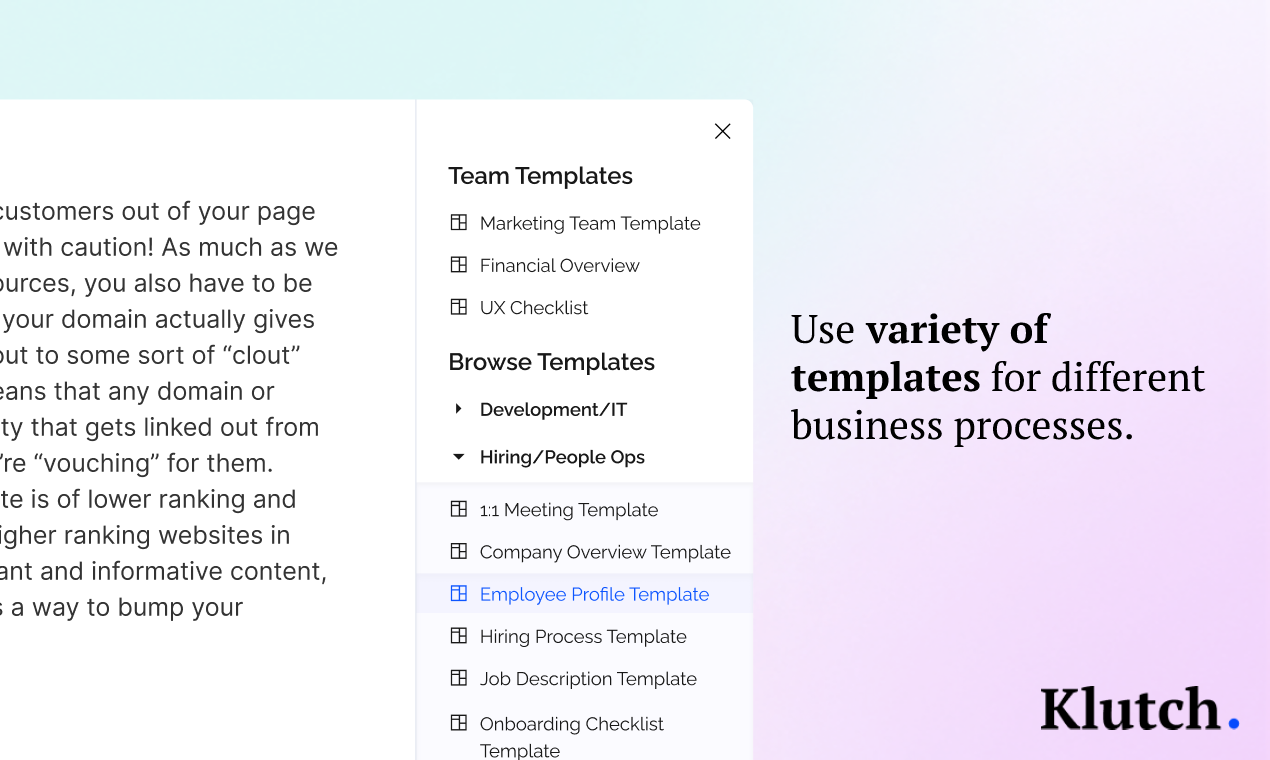A knowledge base is a centralized repository of content, data, and information that enables companies to access, store, and manage information in one platform. It is often used through intranet software, allowing companies to interconnect around data and save time.
The aim is to provide data in a readily accessible format, helping companies to serve customers better, and educate sales teams and staff.
In addition, such management tools can facilitate business operations and make employees more efficient. A well-created knowledge base also improves a company’s traffic, sales, and customer loyalty and increases general visibility on many giant search engines, such as Google and Yahoo.
How is a Knowledge Base Made?
Creating an adequate knowledge base requires significant effort from a company. It usually involves an investment in software, web hosting, and a team responsible for maintaining and organizing the content.
However, the return on that investment is huge. By having a central repository of data that is relevant, accessible, and updated regularly, companies can benefit from a more productive workforce and also give back improved customer service.
Many corporate giants anticipate a 20% increase in productivity levels due to implementing knowledge base management.
Additionally, it can drive traffic to your website or social media from people searching for those FAQs. Moreover, knowledge bases help maintain a culture of continuous learning for employees and grant them access to company-specific information and helpful resources.
This can significantly improve their productivity by allowing them to quickly and easily access the information they need in one platform.
If your business is looking to create and host a knowledge base, many intranet software and template solutions are available to fit your needs. Investing in the right solution that fits your company size, budget and goals are essential to the success of your knowledge base.
6 Essential Tips to Create an Engaging Knowledge Base
Organizing a knowledge base can be challenging, however. It requires careful planning and hosting of a variety of data. Companies need to map out the structure and categories of their knowledge base to ensure it is user-friendly and provides the most accurate results.
A professionally created knowledge base can streamline customer support inquiries, drive website traffic, grant employees access to company-specific information, and improve overall productivity.
With intranet software, you can create a centralized hub for your business and customize it to suit your needs.
1. Store Information Efficiently
Organizing crucial information is the first step to creating an engaging knowledge base. Develop a file structure and a system that works best for your business to keep your data well-kept and up-to-date.
This will make it easy to browse the available content, ensuring the user experience is positive.
Make sure you create a structure that is easy to navigate and understand and that all company data is appropriately categorized and labeled.
2. Personalize Everything
Remember to add a personal touch! Use your company logo to create a branded intranet page and customize text files, videos, and other media to make the knowledge base system more user-friendly.

Source: Klutch Knowledge Base
The company’s branding also helps foster a sense of identity and ownership for the employees in their roles. Additionally, businesses can personalize intranets with custom features such as employee names and job titles.
3. Encourage Employee Interaction
Another great way to make your knowledge base more engaging is to allow collaboration. This could encourage employees to add content or suggest ways to improve the intranet page. In addition, optimizing keywords can help staff find vital information easily.
On top of that, employee profiles can also be uploaded to the base. Companies can store information on these profiles, such as contact details, interests, tasks/projects history, career path, etc.
This allows staff members to get to know each other better and access important information in a single place.
4. Ensure Accessibility
Businesses should ensure their knowledge base is accessible to all organization members. This involves ensuring the intranet can be opened from any device or location. Additionally, the features incorporated should allow users to modify the settings to meet their needs.
Companies should also provide support to users, either through live chat or helpdesk systems. This will ensure customers get the answers they need quickly.
Approximately 58% of US consumers will switch brands due to poor customer service, which heavily emphasizes the need for a thorough helpdesk or FAQ section.
Some multiple tools and platforms can help create a customized knowledge base. These services often come with helpful features such as templates and search capabilities.
5. Upload Informational Content
The content you create for your knowledge base should be relevant and actionable. Write blogs and articles to help educate your employees on the topics they need to know. Additionally, provide information that is easy to search and find.

On the other hand, a FAQ section can serve as the go-to place for company staff members and visiting customers. Streamlining the flow of data helps to reduce wasted time and promote efficiency throughout your organization. Additionally, the content uploaded should be written in the company’s brand voice.
One centralized repository further ensures that the correct information is readily available, improving your organization’s productivity. Additionally, a knowledge base system can also be used to easily produce reports and gather data to monitor progress and track goals.
6. Create Relevancy
Ensure that the content of your knowledge base is relevant to the organization and that it clearly outlines processes, policies, and procedures. Additionally, using visuals and different formats to create information can help make data more accessible and engaging.
Establishing a solid set of guidelines is essential for creating a thriving knowledge base. Define the project’s vision, purpose, and objectives, and develop a checklist of tasks and milestones that need to be completed to reach that goal.
The Benefits of a Collaborative Knowledge Base
A knowledge base is invaluable, as it brings all of the required information into one central location, which can be easily accessed and navigated by both employees and customers.

All the previously distributed knowledge between different users, departments, and teams can now be stored in one place, making it simpler to manage, update and maintain.
From a client’s perspective, almost 63% of customers will rely on a pre-existing knowledge base before reaching out to external helpdesks. This stat shows how important and beneficial a detailed management system is for companies.
- Saves Time
In addition to a better organizational structure, a well-constructed knowledge base can be used to improve customer service.
Customers can quickly fix any issues and view answers to their queries by easily accessing all the required information. This means that customer support teams can focus on more complex customer inquiries and, in turn, increase consumer satisfaction.
- Improves Marketing
A knowledge base can be an additional marketing tool by hosting useful content related to the company’s products and services.
This can increase website traffic and help with Search Engine Optimization (SEO). It can also assist customers in finding the answers they’re looking for, as it serves as a comprehensive FAQ section.
Companies can easily create, store, manage, and update their knowledge base with content using intranet software. Hosting a knowledge base also helps organize the growing data collection and saves space that would otherwise be taken up by additional storage.
- Helps Staying Updated
Regardless of a company’s size, many teams, departments, and individuals can easily access the same information without going through a lengthy process.
This saves valuable time and resources and allows employees to stay up-to-date with the latest information, leading to improved productivity across the organization.
Did you know that about 40% of US workers have reported increased productivity when working from home following the Covid-19 pandemic? As a result, workers’ demand for knowledge-based management software has also increased.
- Creates Interaction
A knowledge base software encourages corporate communities to thrive through regular engagement.
The right system should provide the information needed and create a positive environment where employees can easily collaborate on projects and come up with innovative solutions. Use tabs, labels, and tags to sort content and make it easily searchable by users.
Conclusion
Creating a knowledge base software is a great way to streamline communication and interaction between employees in a company.
It is a tool that helps promote a positive work environment by providing employees with access to the information they need to become more successful and make better decisions. Moreover, when done right, a knowledge base can significantly improve worker productivity and customer satisfaction.
This is especially useful for organizations with staff members in different locations, as the system can help them communicate more effectively. Additionally, it reduces the need for constant message relaying and enables a faster decision-making process.



